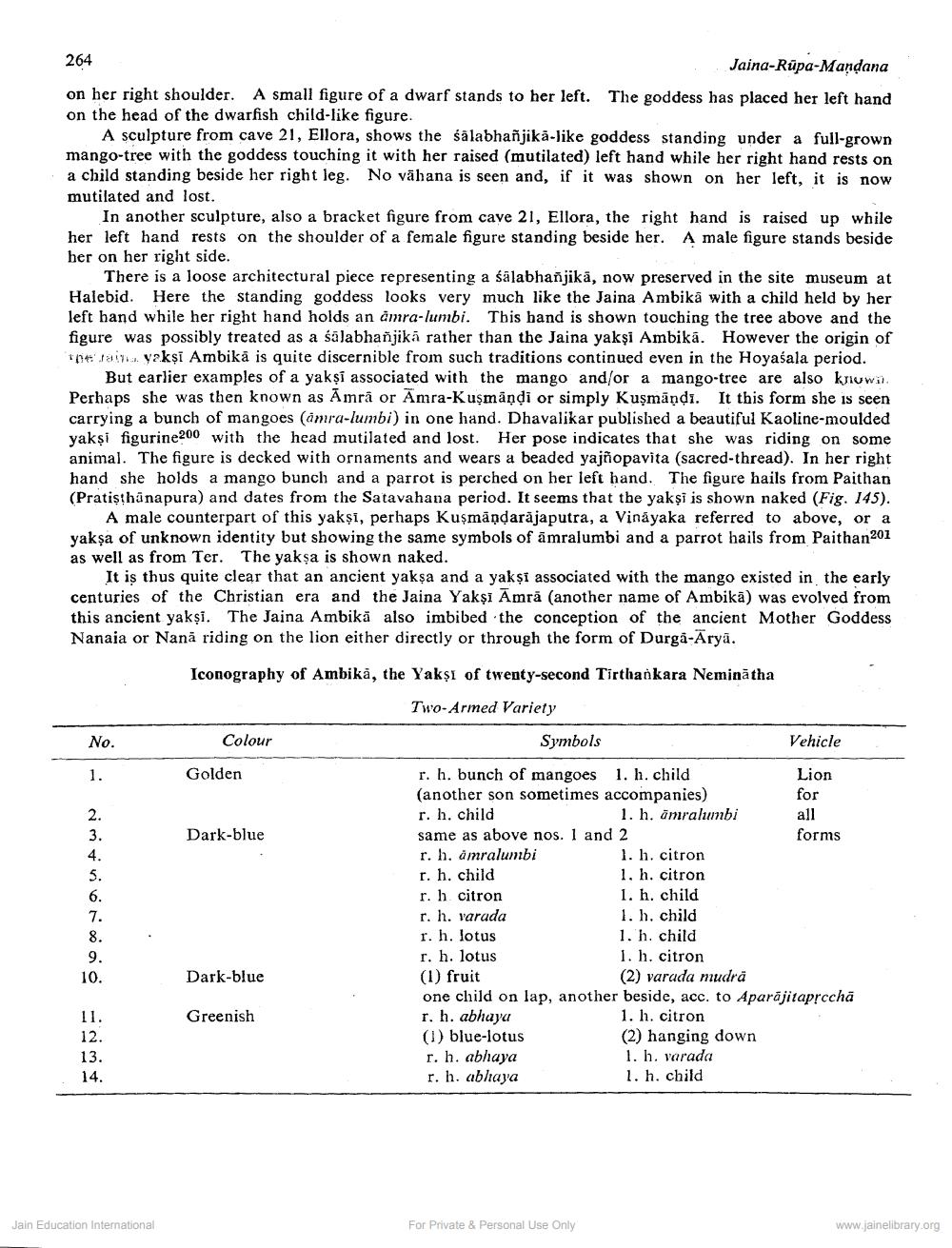________________
264
Jaina-Rūpa-Mandana on her right shoulder. A small figure of a dwarf stands to her left. The goddess has placed her left hand on the head of the dwarfish child-like figure.
A sculpture from cave 21, Ellora, shows the salabhanjika-like goddess standing under a full-grown mango-tree with the goddess touching it with her raised (mutilated) left hand while her right hand rests on a child standing beside her right leg. No vähana is seen and, if it was shown on her left, it is now mutilated and lost.
In another sculpture, also a bracket figure from cave 21, Ellora, the right hand is raised up while her left hand rests on the shoulder of a female figure standing beside her. A male figure stands beside her on her right side.
There is a loose architectural piece representing a śālabhanjikā, now preserved in the site museum at Halebid. Here the standing goddess looks very much like the Jaina Ambikä with a child held by her left hand while her right hand holds an amra-lumbi. This hand is shown touching the tree above and the figure was possibly treated as a śālabhanjikā rather than the Jaina yakşi Ambikā. However the origin of 10 yakşi Ambika is quite discernible from such traditions continued even in the Hoyasala period.
But earlier examples of a yakşi associated with the mango and/or a mango-tree are also kriowa). Perhaps she was then known as Amrå or Amra-Kuşmāņdi or simply Kuşmandı. It this form she is seen carrying a bunch of mangoes (amra-lumbi) in one hand. Dhavalikar published a beautiful Kaoline-moulded yaksi figurine 200 with the head mutilated and lost. Her pose indicates that she was riding on some animal. The figure is decked with ornaments and wears a beaded yajñopavita (sacred-thread). In her right hand she holds a mango bunch and a parrot is perched on her left hand. The figure hails from Paithan (Pratisthānapura) and dates from the Satavahana period. It seems that the yakşi is shown naked (Fig. 145).
A male counterpart of this yaksi, perhaps Kuşmāņdarājaputra, a Vinayaka referred to above, or a yaksa of unknown identity but showing the same symbols of amralumbi and a parrot hails from Paithan201 as well as from Ter. The yakşa is shown naked.
It is thus quite clear that an ancient yaksa and a yakşi associated with the mango existed in the early centuries of the Christian era and the Jaina Yaksi Amra (another name of Ambikā) was evolved from this ancient yaksi. The Jaina Ambika also imbibed the conception of the ancient Mother Goddess Nanaia or Nană riding on the lion either directly or through the form of Durga-Arya.
Iconography of Ambikā, the Yakși of twenty-second Tirthankara Neminātha
Two-Armed Variety
Symbols
No.
Colour
Vehicle
Golden
Dark-blue
r. h. bunch of mangoes 1. h. child
Lion (another son sometimes accompanies)
for r. h. child
1. h. āmralunbi all same as above nos. 1 and 2
forms r. h. amralumbi
1. h. citron r. h. child
1. h. citron r. h citron
1. h. child r. h. varada
1. h. child r. h. lotus
1. h. child r. h. lotus
1. h. citron (1) fruit
(2) varuda mudra one child on lap, another beside, acc. to Aparăjitaprccha r. h. abhaya
1. h. citron (1) blue-lotus
(2) hanging down r. h. abhaya
1. h. varada r. h. abhaya
1. h. child
Dark-blue
Greenish
Jain Education International
For Private & Personal Use Only
www.jainelibrary.org




